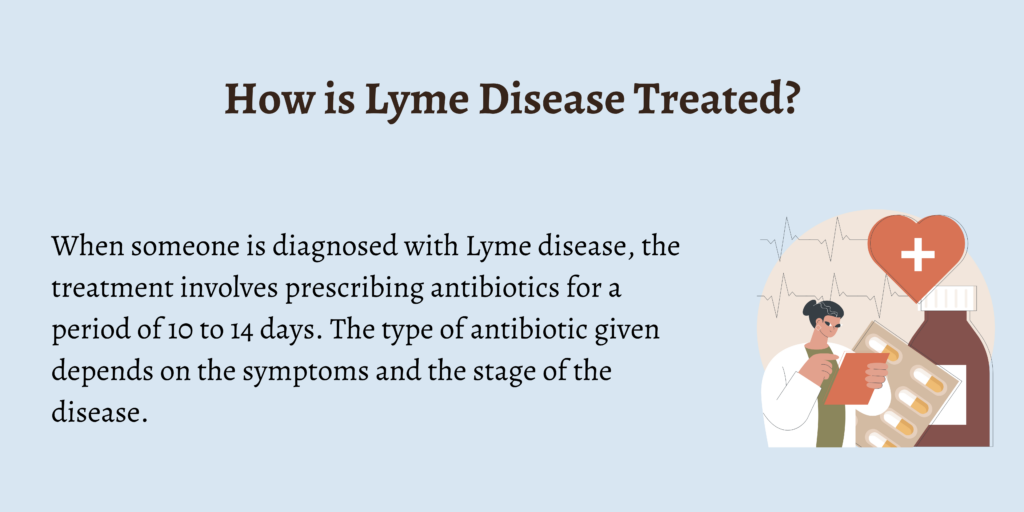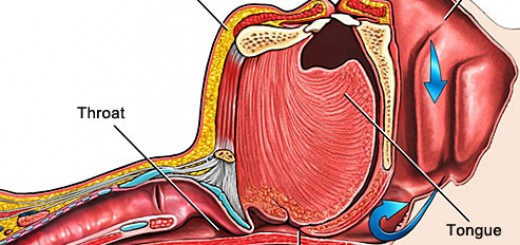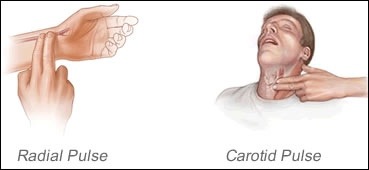What is Lyme Disease?
Lyme disease is a bacterial infection caused by Borrelia burgdorferi when an infected deer tick or blacklegged tick bites a human being.
The tick stays attached to the skin for anywhere between 36 to 48 hours, and the infection can be prevented if the tick is removed within 48 hours. If someone gets affected by Lyme disease, a rash appears at the initial stage, which can also fade away without any treatment.
The infection was first recognized in Lyme, Connecticut, in 1975 when several children were diagnosed with juvenile rheumatoid arthritis, and it was found that the outbreak was due to bites from infected deer ticks.
In this article, we will be discussing the various stages of Lyme disease, how to prevent it, its symptoms, and much more.
What Causes Lyme Disease?
Lyme disease is caused by Borrelia burgdorferi, a bacteria that is carried by deer ticks. The bacteria get picked up by ticks from a host, such as a deer, and they then pass it on to another host. The bacteria can travel to an individual’s bloodstream when an infected tick feeds on them.
What are the Stages of Lyme Disease?
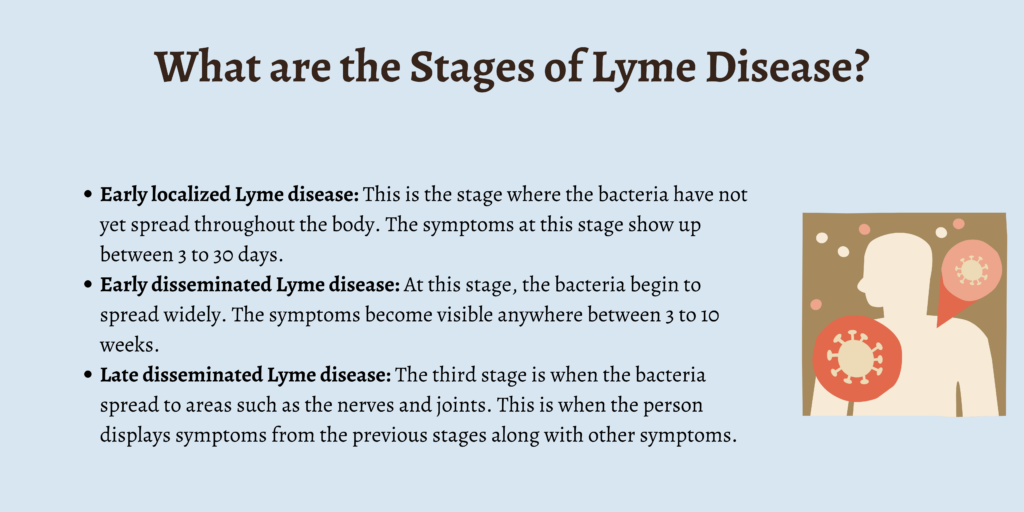
There are three stages of Lyme disease, namely:
- Early localized Lyme disease: This is the stage where the bacteria have not yet spread throughout the body. The symptoms at this stage show up between 3 to 30 days.
- Early disseminated Lyme disease: At this stage, the bacteria begin to spread widely. The symptoms become visible anywhere between 3 to 10 weeks.
- Late disseminated Lyme disease: The third stage is when the bacteria spread to areas such as the nerves and joints. This is when the person displays symptoms from the previous stages along with other symptoms.
What are the Symptoms of Lyme Disease?
The symptoms of Lyme disease can be divided according to the stages involved. The symptoms during the first stage include:
The second stage symptoms are:
- Stiff neck or neck pain
- Rashes on different areas of the body
- Weakness, numbness, or pain in the feet or hands
- One or both sides of the face having muscle weakness
- Meningitis accompanied by fever and severe headache
- Heart issues
The symptoms of the third stage of Lyme diseases are as follows:
- Difficulty concentrating
- Damaged nerves
- Swollen joints or arthritis
How Common is Lyme Disease?
Every year, about 30,000 cases of Lyme disease get reported in the United States of America. There are also several diagnosed cases that don’t get reported.
Who is at Risk for Lyme Disease?
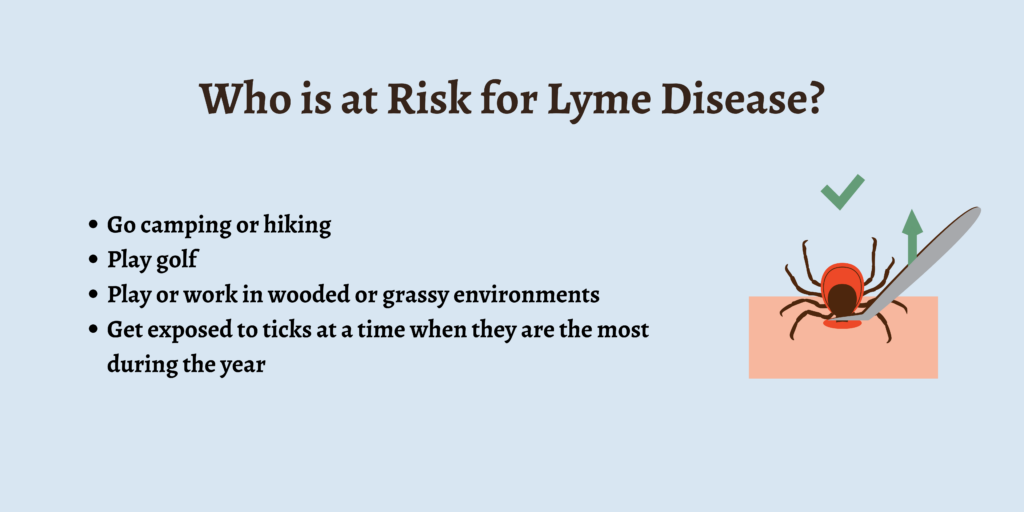
The risk for Lyme disease is present across all age groups. The risk increases when you:
- Go camping or hiking
- Play golf
- Play or work in wooded or grassy environments
- Get exposed to ticks at a time when they are the most during the year
How is Lyme Disease Diagnosed?
The diagnosis of Lyme disease depends on:
- The symptoms displayed by the person
- Whether they were in an area filled with ticks
- Physical signs such as rashes
A blood test will be conducted to confirm that the individual has Lyme disease. If the first test comes back negative, you won’t have to be tested again. If it comes back positive, a second test will be conducted since two positive results indicate the presence of Lyme disease.
How is Lyme Disease Treated?
When someone is diagnosed with Lyme disease, the treatment involves prescribing antibiotics for a period of 10 to 14 days. The type of antibiotic given depends on the symptoms and the stage of the disease.
When to Suspect Lyme Disease
Because deer ticks are so tiny, most people never notice being bitten. If you live in an area where infected ticks are active, be suspicious of any flulike illness that your child develops during the spring, summer or early fall.
The first sign of Lyme disease is often a distinctive, circular rash appearing from several days to two weeks after the tick bit. Beginning like a tiny red pimple, the rash expands to a red circle that may be clear in the center, resembling a bull’s eye. Even without treatment, the rash will usually disappear within a few weeks. However, nearly half of all people with Lyme disease never develop the classic rash. Among those who do develop a rash, 50 percent go on to have small red blotches and circles in the thigh or groin within several days. Conjunctivitis may also appear.
The next early sign to watch for is a flulike illness, characterized by a headache, aching muscles, fever, chills, painful joints, a stiff neck or a sore throat. Even without treatment, this illness will usually disappear within a week to ten days, although the accompanying fatigue may persist for weeks or months.
If the disease escapes detection in these early stages, many children go on to develop arthritis, abnormal heart rhythms and nervous system problems.
When to See a Doctor for Lyme Disease
If you feel sick after having spent time in an area that has a lot of ticks, then you should definitely contact your doctor to get yourself checked.
You should also contact them if you don’t feel better even after taking the antibiotics prescribed to you to recover from Lyme disease. This especially holds true if you experience symptoms such as mental confusion or a stiff neck.
How to Prevent Lyme Disease
Here are a few ways to prevent Lyme disease:
- Use safe insect repellants on your body and clothes whenever needed.
- Wear light-colored clothes in areas with a lot of ticks so they can be detected easily.
- Check for ticks after participating in outdoor activities, and make sure to shower and scrub yourself properly.
- Check your pets for ticks.
- Wear a hat, and don’t leave your feet exposed in outdoor environments that are known to have plenty of ticks.
- Wear long-sleeved shirts and long pants to keep your skin safe and not exposed to ticks.
- Try to stay away from areas that have high grass.
- Remain extra alert for ticks during the warmer months.
How to Remove a Tick
When a tick gets attached to your skin, take the following steps to remove it:
- Use tweezers to grab the tick close to its mouth or head. Don’t use fingers for this purpose. You can also opt for a paper towel or tissue.
- Pull it out steadily and slowly.
- Use water and soap to clean the area thoroughly, and wash your hands well.
Post-Treatment Lyme Disease Syndrome
Some people could experience headaches, aches, or fatigue even after receiving the necessary treatment for Lyme disease, and this is called post-treatment Lyme disease syndrome or PTLDS.
The symptoms associated with post-treatment Lyme disease syndrome don’t mean that the person still has an infection, and the syndrome doesn’t usually get better through more antibiotics. Most people feel the symptoms going away on their own in about six months.
Can Lyme Disease be Completely Cured?
Antibiotics help in treating Lyme disease, and the patients usually recover within two to four weeks of beginning the treatment.
These antibiotics may also be needed to be given to the person through the vein for about four more weeks as a part of the treatment. However, when early treatment is involved, Lyme disease doesn’t stay inside a person forever.
FAQs
1. When was Lyme disease first identified?
Lyme disease was first identified in 1975.
2. What are the symptoms of Lyme disease?
The symptoms of Lyme disease in the early stage include fever, fatigue, and headache.
3. How can Lyme disease be prevented?
Lyme disease can be prevented by applying insect repellants, keeping your body covered with long pants and long-sleeve shirts, and checking for ticks after being outdoors.
4. Can Lyme disease be completely cured?
Yes, Lyme disease can be completely cured.
5. Who is at risk for Lyme disease?
The risk for Lyme disease increases when someone works in wooded or grassy environments or is exposed to areas that have a lot of ticks.
Conclusion
If anyone gets afflicted with Lyme disease, they can recover when proper treatment is administered early on. Long-term effects could still be present even after a person receives the required treatment.
However, untreated cases of Lyme disease can bring about other health issues, which is why it’s vital to treat the condition as soon as possible.
Make sure to take the antibiotics prescribed by your doctor, and do reach out to your healthcare provider if you feel sick after being in an environment that has ticks.

